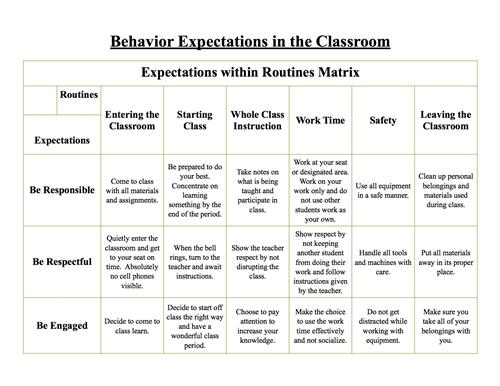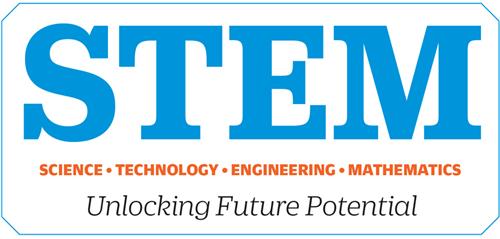-

PS duPont Middle School S.T.E.M. Course Syllabus
Name of Course: S.T.E.M. Department: Engineering & Technology Education
School Year: 2017-2018 Name of Teacher: Mr. Fawks
Email address: samuel.fawks@bsd.k12.de.us Phone number: 762-7146
I. Required MaterialsEach student must have a spiral notebook and pocket folder for S.T.E.M. All of the student’s work, including warm-up exercises, notes, classwork, homework, copied packets, projects, quizzes, and tests, should be ordered by date and kept in the folder. With the notebook and pocket folder, students must bring their workbook and pencils to class every day. Being prepared for class means having the required materials at your desk when the bell rings.
II. Homework ExpectationsHomework assignments will be given periodically. These assignments are to be completed on the day they are assigned. Late work will not be given credit. It is the responsibility of an absent student to get any missed assignment(s) from another student or Mr. Fawks either before or after class. Missed work must be made up within the number of days allowed under Brandywine School District policy. Messy or incomplete work will not receive credit. Pride and the appropriate amount of time should be given to each assignment. There will be no “grace period” for a student to recopy the assignment. It is the student’s responsibility to make sure that his/her work is presentable and completed as instructed.
III. Grading PolicyGrades will be based on formative work (30%), and summative work (70%).
Grading scale used by the Brandywine School District for all subjects.A Excellent! 90–100%
B Good! 80–89%
C Satisfactory 70–79%
D Needs improvement 60–69%
F Not achieving 0–59%IV. Daily classroom instruction will consist of:
- Reviewing concepts from the previous day’s lesson
- Presenting new content or extending topics from a previous lesson
- Group work - Students will be required to work in teams on stemgineering challenges
- Individual/whole group practice
- Behavior Expectations (Refer to the following matrix.)

V. Course Sequence (This is a guide, and may not be followed exactly!)
S.T.E.M. (Science, Technology, Engineering & Math)Design & ModelsCivil EngineeringMechanical EngineeringElectrical EngineeringAerospace EngineeringEnvironmental EngineeringChemical EngineeringBiological/Biomedical EngineeringCareersFinal Exam ReviewFinalVI. S.T.E.M. ProjectsA S.T.E.M. project will be assigned during each marking period. Failure to complete the project will result in a "0" grade.VII. Other important items specific to this course:· I am committed to making sure as many students as possible find success in S.T.E.M. throughout high school. There must be a commitment from both student and parent to completing all of the assignments and seeking help immediately when needed. When your child struggles this year, be willing to talk with me and work with me to find the reason for the difficulty. The sooner the problems can be identified, the greater the likelihood that we can work together to assure success in this course.
VIII. Standards
ITEEA STL = Standards for Technology Literacy from the International and Engineering Education AssociationNGSS MS-ETS = Middle School Standards for Engineering, Technology & Applications of Science from the Next Generation Science Standards.CCSS RST = Reading in Science & Technical Subjects from Common Core State StandardsCCSS WHST = Writing in History, Science & Technical SubjectsCCSS SL = Speaking & ListeningCCSS EE = Expressions & EquationsCCSS SP = Statistics & ProbabilityS.T.E.M. DOMAIN- Demonstrate an understanding of the relationship among technologies and other fields of study. (ITEEA STL 3)
- Define the criterial and constraints of a design problem with sufficient precision to ensure a successful solution, taking into account relevant scientific principles and potential impacts on people and the natural environment that may limit possible solutions. (NGSS MS-ETS1-1)
PROBLEM SOLVING DOMAIN
- Apply troubleshooting, research and development, invention and innovation, and experimentation in problem solving. (ITEEA STL 10)
- Analyze data from tests to determine similarities and differences among several design solutions to identify the best characteristics of each that can be combined into a new solution to better meet the criteria for success. (NGSS MS-ETS1-3)
- Cite specific textual evidence to support analysis of science and technical texts. (CCSS RST.6-8.1)
- Integrate quantitative or technical information expressed in words in text with a version of that information expressed visually. (CCSS RST.6-8.7)
- Solve multi-tep real-life and mathematical problems posed with positive and negative rational numbers in any form (whole numbers, fractions, and decimals), using tools strategically. Apply properties of operations to calculate with numbers in any form: convert between forms as appropriate; and assess the reasonableness of answers using mental computation and estimation strategies. (CCSS MATH 7.EE.3)
WORLDVIEW DOMAIN- Demonstrate an understanding of the cultural, social, economic, and political effects of technology. (ITEEA STL 4)
- Demonstrate an understanding of the effects of technology on the environment. (ITEEA STL 5)
- Demonstrate an understanding of the role of society in the development and use of technology. (ITEEA STL 6)
- Demonstrate an understanding of the influence of technology on history. (ITEEA STL 7)
- Demonstrate the ability to assess the impact of products and systems. (ITEEA STL 13)
- Demonstrate an understanding that all human activity draws on natural resources and has both short and long-term consequences, positive as well as negative, for the health of people and the natural environment. (NGSS MS-ETS1-1 Crosscutting Concept)
TECHNOLOGY DOMAIN- Demonstrate an understanding of the characteristics and scope of technology. (ITEEA STL 1)
- Demonstrate an understanding of the core concepts of technology. (ITEEA STL 2)
- Demonstrate the ability to use and maintain technological products and systems. (ITEEA STL 12)
- Demonstrate an understanding that the uses of technologies and limitations on their use are driven by individual or societal needs, desires, and values; by the findings of scientific research; and by differences in such factors as climate, natural resources, and economic conditions. (NGSS MS-ETS1-1 Crosscutting Concept)
- Integrate multimedia and visual displays into presentations to clarify information, strengthen claims and evidence, and add interest. (CCSS SL.8.5)
DESIGN CYCLE DOMAIN- An understanding of the attributes of design. (ITEEA STL 8)
- An understanding of engineering design. (ITEEA STL 9)
- The ability to apply the design cycle. (ITEEA STL 11)
- Evaluate competing design solutions using a systematic process to determine how well they meet the criteria and constraints of the problem. (NGSS MS-ETS1-2)
- Develop a model to generate data for iterative testing and modification of a proposed object, tool, or process such that an optimal design can be achieved. (NGSS MS-ETS1-4)
- Compare and contrast the information gained from the experiments, simulations, video, or multimedia resources with that gained from reading a text on the same topic. (CCSS RST.6-8.7)
- Conduct short research projects to answer a question (including a self-generated question), drawing on several sources and generating additional related, focused questions that allow for multiple avenues of exploration. (CCSS WHST.6-8.7)
- Gather relevant information from multiple print and digital sources, using search terms effectively; assess the credibility and accuracy of each source; and quote or paraphrase the data and conclusions of others while avoiding plagiarism and following a standard format for citation. (CCSS WHST.6-8.8)
- Draw evidence from informational texts to support analysis, reflection, and research. (CCSS WHST.6-8.9)
- Develop a probability model and use it to find probabilities of events. Compare probabilities from a model to observed frequencies; if the agreement is not good, explain possible sources of the discrepancy. (CCSS MATH 7.SP)

Select a School...
Select a School
- Brandywine High School
- Carrcroft Elementary
- Charles W. Bush Pre-School
- Claymont Elementary
- Concord High School
- Forwood Elementary
- Hanby Elementary
- Harlan Elementary
- Lancashire Elementary
- Lombardy Elementary
- Maple Lane Elementary
- Mt. Pleasant Elementary
- Mt. Pleasant High School
- P.S. duPont Middle School & ECAP
- Springer Middle School
- Talley Middle School

